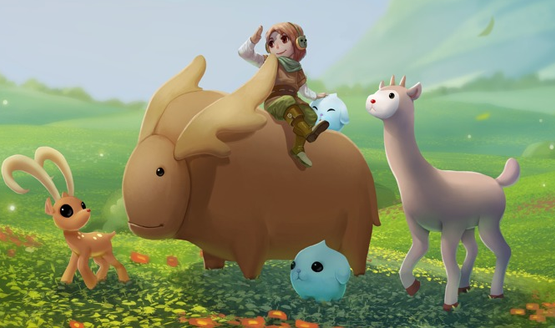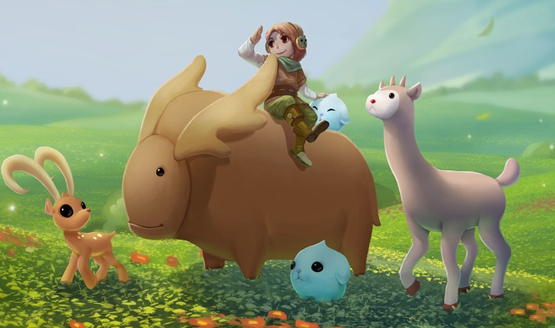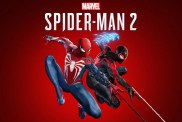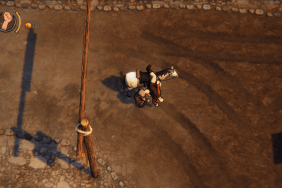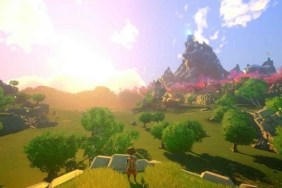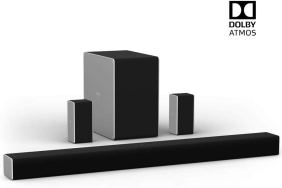PSLS: You mentioned sound effects and I think foley is fascinating, when looking at audio recordings. Were there any interesting foley recordings that you did for Yonder that people might not expect to be in there? Any bizarre effects where you created a sound out of two weird household objects?
Stephan: There are an awful lot of environmental sounds in it, as in nature, birds, insects, etc. This is a classic foley trick, but I love it, and I love how simple and effective it is. In Yonder there are four or five occasions were you’ve got stone monuments that you interact with. There are a couple of puzzles that have giant stone statues, two or three times a person’s size, and they can be rotated, which is funny when you think about how heavy these things would be.
But the player comes up, you press a button, and this giant statue rotates. You need to have that exciting textural sound to make you feel like there’s this giant block in front of you. It was one of the first dynamic sounds that we put into the game. I created this sound and I sent them to Joel and said ‘There you go, code those up. Use this sound for the rotation and this sound for when it locks in place, and then there’s another stone statue that rises up,’ and he types back to me on Skype and says ‘Oh my god! That’s like audio porn! It’s so cool, I love it so much because it brings that whole thing to life!’ and he was really, really happy with the result. He felt that it gave weight. It was an exciting thing to do.
It was a simple puzzle, but it really added excitement to the whole thing. Previously, you’d press it and this 3D model of a statue would rotate. But all of a sudden, with this sound in there, it’s got this [imitates grinding noise] grinding stone, and when it locks in place, there was sort of this shower of sand and rubble. The funny thing about that is that the way you make the sound of giant stones grinding against each other is literally to get two household bricks and just rotate them, then pitch shift it down.
In the early years when I started working, I was trying all of these effects buttons and plugins in my digital audio workstations, and I never quite got them to work the way I wanted to. Over the years I realized that essentially there are three main tools for sound design that will give you 90% of what you need. They are really simple. Basically they are: Volume, louder or softer. Pitch, higher pitch or lower pitch. And time, which is related to those two, when you stretch out a sound or compress it.
When you do analog stuff it’s like speeding up or slowing down a record player or tape deck. When you slow [slowing his own voice]… it gets longer, like a guitar string, the longer it gets, the lower it gets. So using that analog thing, if I go scrape, scrape, scrape [imitates scraping bricks together] and I pitch shift that down a long, long, long way, all of a sudden it goes [imitates low rumbling], and it becomes this really grindy rumbly sound.
So suddenly you can depict this scene of a massive pyramid or a stone block the size of your house shifting out of the way, and how have you done that? You’ve done it with a couple of household bricks and dialed it down. It’s one of the things I love about working with sound and music, because all these amazing effects can literally by you picking something up around the house and banging it together then dialing it in.
PSLS: Is there anything that came up where, instead of looking for the sound, you found it, made a really cool sound and said ‘I have to have that somewhere in the game or somewhere in the soundtrack?’
Stephan: I’ve done that with many other games. I also create commercial sound effects libraries, so over the years, we’ve built up our collection, and our sound libraries are used worldwide by EA, Warner Bros., Activision, Disney, Skywalker Sound, etc. So I’ve spent a lot of time going out and recording things. I love recording things, and there are definitely things I’ve recorded where I’ve been like ‘Oh, that is so incredible! I must get that in!’
There was that in Yonder, but it wasn’t a machine or anything like that. The thing about Yonder that I really love is that it had an anime sort of feel to it, that Japanese RPG/anime/Ghibli style feel to it. One of the things that was really exciting was that we had spent three years living in Japan, many years ago. Whilst I was in Japan, I did a lot of recording. That’s where we started building up the libraries that we ended up selling. One of the things about Japan that’s amazing is Japan has different species of insects across the whole country. Once I discovered this, you can watch a Japanese anime, and if you hear insects it means two things usually.
If you watch Evangelion, perfect example, and you hear the insects, you now know it’s summer, you know the season, but you also know where in Japan it is because they have different insects up north, different insects in Tokyo, different insects down south. What was exciting was that I got to put a lot of these insects into Yonder. I had these recordings for many years. I think Yonder has over 40 different species of bird and insect sounds.
There’s seven different biomes, so every biome has a different breed of insect for daytime, then for nighttime and between summer and winter. It’s actually crazy complex. 99% of people will never notice this, but as you go from summer to winter, some bird species will stop making noise during the day at all, because the whole idea is that they’ve flown south for the winter. They’ve gone somewhere else. So in winter you might get no birds, but a different type of cricket. And then in summer, different types of insects.
There’s a particular one that I recorded just west of Tokyo that are these really loud insects. They are now in Yonder in the area with the palm trees, that sort of tropical area. Cheryl made a comment the other day saying she really loved it, because for her it was very nostalgic to Totoro. So it made her feel like ‘I’m in a Japanese anime.’ There’s at least one person that has acknowledged that, which was exactly what I was aiming for there.
So it wasn’t a funky mechanical thing or anything like that, but it was sounds that I had collected many years ago that I was so happy to be able to use. In Yonder, there are so many environments around the world and they change through the seasons, and I got to put in all these different species of bird and insects and frogs and things like that.
Stephan goes into three dimensional sound design on the next page.
